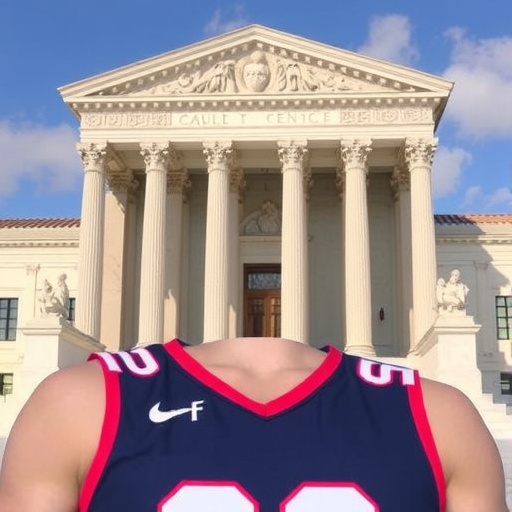Supreme Court Takes on Transgender Athletes’ Rights: Idaho’s Sports Ban Faces Constitutional Scrutiny
In a move that could reshape youth sports across America, the U.S. Supreme Court has agreed to hear a high-stakes challenge to Idaho’s controversial ban on transgender athletes competing in school sports aligned with their gender identity. The case, Hecox v. Little, spotlights the tension between state-level restrictions and federal protections, arriving at a time when more than 25 states have enacted similar sports ban laws targeting transgender students. At its core, the dispute hinges on whether these policies infringe on the Equal Protection Clause of the 14th Amendment, promising a landmark ruling that may echo far beyond Idaho’s borders.
- Idaho’s Fairness in Women’s Sports Act Ignites Firestorm of Controversy
- Personal Stories: Transgender Teens Navigate Exclusion and Resilience
- Legal Battleground: Equal Protection Claims Challenge State Bans
- National Ripple Effect: More Than Half of States Enact Transgender Sports Restrictions
- Future Horizons: How a Supreme Court Ruling Could Redefine Youth Sports
The decision to grant certiorari comes amid growing national polarization over transgender rights in athletics. Proponents of the Idaho law argue it safeguards opportunities for cisgender female athletes, while critics, including the plaintiffs—a cisgender woman and a transgender woman—contend it discriminates against an already marginalized group. With oral arguments slated for the fall term, this case thrusts the Supreme Court into the heart of a cultural flashpoint, where fairness, identity, and inclusion collide on the playing field.
Idaho’s Fairness in Women’s Sports Act Ignites Firestorm of Controversy
Enacted in 2020, Idaho’s Fairness in Women’s Sports Act was the nation’s first statewide Idaho law prohibiting transgender girls and women from participating in female sports teams at public schools and colleges. Signed by Republican Governor Brad Little, the legislation mandates that athletes compete based on their sex assigned at birth, effectively barring transgender athletes from teams matching their gender identity. Supporters hailed it as a victory for biological equity, citing concerns that transgender competitors might hold physiological advantages in events like track, swimming, and wrestling.
But the law quickly drew legal fire. Lindsay Hecox, a cisgender woman and longtime runner who identifies as female, joined forces with Lindsay Teddy, a transgender woman and former college athlete, to sue state officials. Their complaint argues that the ban not only excludes transgender students but also chills participation among cisgender women who support inclusion. “This law doesn’t protect women; it divides us,” Hecox stated in a 2021 interview with The New York Times. Federal courts have issued mixed rulings: a district judge blocked enforcement in 2020, only for the 9th U.S. Circuit Court of Appeals to partially uphold it in 2023, sending the case to the Supreme Court.
The statute’s reach extends to K-12 and higher education, affecting thousands of students in a state where youth sports are a cornerstone of community life. Idaho’s population of about 1.9 million includes an estimated 500 to 1,000 transgender youth, according to data from the Williams Institute at UCLA. For these individuals, the ban represents more than a sideline exclusion—it’s a barrier to the social and emotional benefits of team sports, which studies from the American Academy of Pediatrics show can reduce depression rates by up to 30% among LGBTQ+ teens.
Opposition has been fierce. The American Civil Liberties Union (ACLU), representing the plaintiffs, filed an amicus brief emphasizing the law’s overbreadth. “Idaho’s ban isn’t about fairness—it’s about exclusion,” said Chase Strangio, ACLU deputy director for transgender rights. Meanwhile, conservative groups like the Alliance Defending Freedom have rallied behind the state, arguing that Title IX, the federal law prohibiting sex discrimination in education, implicitly supports sex-based categories in sports.
Personal Stories: Transgender Teens Navigate Exclusion and Resilience
Behind the legal briefs are real lives upended by such policies. Take Andraya Yearwood, a transgender track star from Connecticut—not Idaho, but whose story mirrors the national struggle. In 2019, Yearwood faced backlash after winning state championships, fueling the wave of sports ban legislation that followed. Though Connecticut lacks a ban, her experience highlights the human cost: harassment, death threats, and a constant fight for legitimacy.
In Idaho, the impact hits closer to home. A 2022 report by Human Rights Campaign documented cases of transgender students dropping out of sports programs due to fear of outing or discrimination. One anonymous high schooler from Boise shared with NPR, “I just wanted to run with my friends, but now I hide who I am. It’s like the field is a minefield.” Such narratives underscore the emotional toll, with a 2023 survey by The Trevor Project revealing that 60% of transgender youth who face sports exclusion report increased suicidal ideation.
Yet resilience shines through. Becky Pepper-Jackson, a 12-year-old transgender girl from West Virginia, became a symbol of the fight when she sued over a similar ban there. Though her case settled, it paved the way for others. In Idaho, advocates point to success stories like those in states without bans, where inclusive policies have boosted overall participation rates. A study by the Canadian Centre for Ethics in Sport found no widespread dominance by transgender athletes in inclusive environments, challenging claims of unfair advantage.
These personal accounts add urgency to the Supreme Court docket. As one plaintiff’s attorney noted during appeals, “This isn’t abstract constitutional law—it’s about kids who deserve to play without fear.” The justices, known for probing real-world implications, may delve into these stories during arguments, potentially swaying the outcome toward empathy or strict originalism.
Legal Battleground: Equal Protection Claims Challenge State Bans
At the crux of Hecox v. Little is the question of equal protection under the law. The plaintiffs assert that Idaho’s sports ban discriminates on the basis of sex and transgender status, warranting heightened scrutiny from courts. Under Supreme Court precedent like Bostock v. Clayton County (2020), which extended Title VII protections to LGBTQ+ workers, discrimination against transgender people is often treated as sex discrimination. “If firing someone for being transgender violates equal protection in employment, why not in sports?” Strangio argued in a recent op-ed for The Washington Post.
Idaho counters that the law serves a compelling interest in preserving competitive fairness for women, a rationale rooted in decades of Title IX jurisprudence. The state cites physiological differences, such as average muscle mass advantages in males post-puberty, backed by a 2021 study in the British Journal of Sports Medicine showing transgender women retain some strength edges even after hormone therapy. However, critics like the plaintiffs reference counter-research from the American Medical Association, which in 2023 affirmed that individualized assessments, not blanket bans, best ensure equity.
The case also intersects with federalism debates. While states like Idaho claim authority over education policy, opponents invoke the Supremacy Clause, arguing that conflicting state laws undermine national civil rights standards. Amicus briefs from over 50 organizations, including the NCAA and Major League Baseball, urge the Court to strike down the ban, warning of fragmented rules harming interstate competitions. “A patchwork of bans creates chaos for athletes and teams,” said NCAA President Charlie Baker in a statement.
Legal experts predict a divided Court. Justice Sonia Sotomayor, a vocal advocate for LGBTQ+ rights, may push for strict scrutiny, while Justice Clarence Thomas could emphasize states’ rights. The 6-3 conservative majority adds unpredictability, especially post-Dobbs v. Jackson, which curtailed federal abortion protections. A ruling expected by June 2025 could either affirm or dismantle similar laws nationwide.
National Ripple Effect: More Than Half of States Enact Transgender Sports Restrictions
Idaho wasn’t alone in pioneering restrictions on transgender athletes. As of 2024, 26 states—over half the nation—have passed laws or executive orders barring transgender students from sports aligning with their gender identity, according to tracking by the Movement Advancement Project. This surge began post-2019, accelerated by political rhetoric framing the issue as a threat to women’s sports icons like Title IX architect Bernice Sandler.
Texas, Florida, and Arkansas lead the pack with stringent measures, some including criminal penalties for coaches who allow transgender participation. In contrast, 18 states plus Washington, D.C., have explicit protections for transgender athletes, mandating inclusion based on gender identity. This divide has led to absurd scenarios: a transgender swimmer from Missouri relocating to neighboring Illinois to compete, as chronicled in a 2023 ESPN feature.
Statistics paint a stark picture. The National Federation of State High School Associations reports over 8 million U.S. high school athletes annually, with transgender participation estimated at less than 1%. Yet bans have prompted a 15% drop in overall female sports enrollment in affected states, per a 2024 GLSEN study, as allies withdraw in solidarity. Economically, the fallout is notable: lost revenue from tournaments and scholarships, with the U.S. Olympic Committee estimating potential billions in long-term costs if talent pipelines dry up.
Internationally, the U.S. lags behind. The International Olympic Committee allows transgender athletes under hormone guidelines, and countries like Canada emphasize inclusion. Domestically, the Biden administration’s 2021 executive order promoting LGBTQ+ equity clashed with state actions, leading to over 100 lawsuits. As one policy analyst from the Brookings Institution noted, “These bans aren’t just local—they’re eroding the American ideal of equal opportunity in sports.”
The proliferation underscores a cultural shift. Polling by Gallup shows 69% of Americans oppose transgender women in female sports, up from 62% in 2021, driven by media coverage of outliers like Lia Thomas, the transgender swimmer who won an NCAA title in 2022. Yet support for transgender rights overall remains steady at 71%, per Pew Research, suggesting nuanced public views that the Supreme Court may navigate carefully.
Future Horizons: How a Supreme Court Ruling Could Redefine Youth Sports
If the Supreme Court upholds Idaho’s Idaho law, it could validate the sports ban trend, emboldening more states and potentially influencing private leagues like the NFL or NBA on diversity policies. Conversely, striking it down would reinforce equal protection for transgender athletes, possibly requiring hormone testing or case-by-case reviews as alternatives. Legal scholars like Erwin Chemerinsky of UC Berkeley predict a narrow ruling, focusing on Idaho’s specifics to avoid broader mandates.
Beyond the bench, implications ripple through education and health. Schools might invest in training for inclusive environments, reducing bullying incidents reported at 45% among transgender students by the CDC. Federally, Congress could respond with clarifying Title IX regulations, stalled since 2021 amid partisan gridlock. For families, the decision offers clarity: Will sports remain a unifier or a battleground?
Advocates on both sides prepare for mobilization. Transgender rights groups plan awareness campaigns, while conservative coalitions eye legislative overrides. As the Supreme Court deliberates, one thing is clear: this case transcends athletics, testing America’s commitment to equality in an era of division. Youth across the nation await a verdict that could level the playing field—or redraw its lines entirely.









